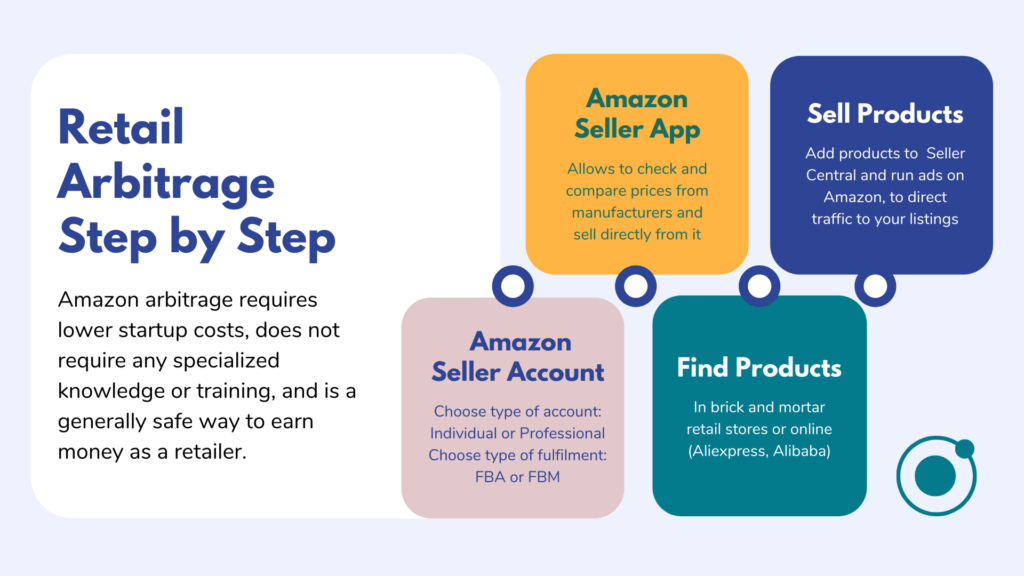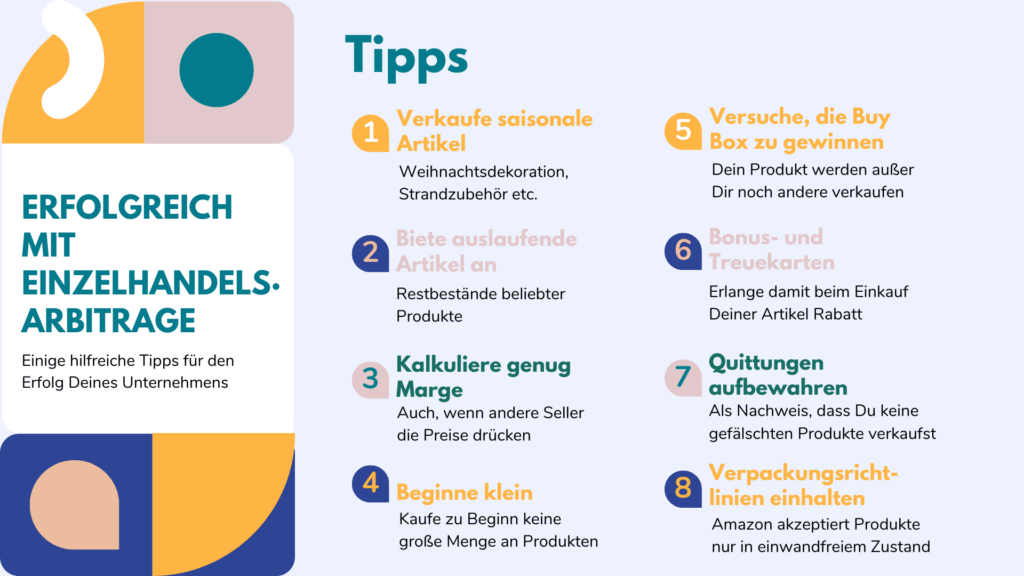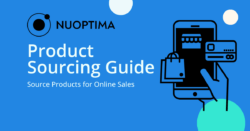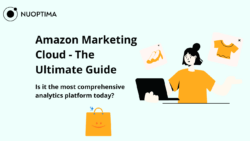Key points
- Amazon arbitrage is the practice of purchasing discounted goods online or at brick-and-mortar stores and reselling them on Amazon at a higher price.
- There are two types of Amazon arbitrage depending on where the goods are purchased: online arbitrage and retail arbitrage.
- Amazon arbitrage has several advantages compared to other business models, as it is generally safer, requires lower startup costs, takes less time to start, doesn’t require the seller to have any specialized knowledge, training, or equipment, etc.
- To start a retail arbitrage business, you first need to create an Amazon Seller Account, install the Seller App, select and find suitable products to sell, list them on the platform, and fulfill orders when they come in.
If you’ve ever considered selling on Amazon, you’ve probably heard of retail arbitrage. There are numerous claims that it is the best way to launch your own e-commerce business. Indeed, if you are unsure about the products you want to manufacture or sell, have a limited budget, and are new to the Amazon business, retail arbitrage is an excellent option for you. Purchasing items at a discount and then reselling them at a higher price may seem too easy to be a profitable idea, and we completely understand this. So let’s delve deeper into the matters surrounding retail arbitrage to see if it’s possible to make money reselling products you find on other marketplaces on Amazon.
What is Amazon Arbitrage?
The idea of retail arbitrage may appear complicated, but it is the most straightforward way for novice sellers to enter the e-commerce business. Sellers who use this method look for discounted or bargain goods in physical stores (Walmart, Target) or online markets (eBay, Alibaba) and buy them with the intent of reselling them at a higher price on other marketplaces. Let’s look at an example. Product A is available on Amazon for $25, but the same item is available at a local store for $15 because of a discount. It’s an ideal situation for arbitrage sellers: all they have to do is buy products in their local store for $15 and sell them on Amazon for around $20. Isn’t that an excellent strategy? This gives you a healthy profit margin while still allowing you to sell the product for less than the retail price! There are two ways to find products to resell on Amazon:
- Online Arbitrage. Sellers use this method to purchase products from other online marketplaces like eBay, Walmart.com, or Alibaba and then resell them on Amazon. You may not even need to store the products in your own warehouses; simply list them on Amazon and ship them directly from another online marketplace to your customers.
- Retail Arbitrage. Retail arbitrage is the practice of obtaining products from physical retail stores. Obviously, you will need more time to visit various stores and find appropriate products in bulk with discounts.
You’re probably wondering how retail arbitrage differs from regular retailing. Because you are buying directly from a retail store or market, you do not need to be connected to suppliers or manufacturers when using retail arbitrage. Of course, your profit margin will be lower, but it will be far easier than finding suppliers and ordering items from them.
What is the difference between retail arbitrage and other Amazon business models?
There are several other business models you can utilize for your Amazon business, but all of them are significantly different from retail arbitrage.
- Private labeling: This means rebranding a product that was previously manufactured under a white label. Because there is no need for a supply chain, this model takes less time, but there are no options for personalizing the products if something doesn’t suit you.
- Wholesale: This model is similar to the arbitrage model in that you buy low-cost or discounted goods in bulk rather than finding individual units. Obviously, making money on bulk items is easier, but there is a chance that you will order a large number of goods that don’t sell well and end up with excess stock.
- Dropshipping: Dropshipping is a business model when a seller does not keep physical stock in their warehouse and instead transfers orders directly to a third-party supplier. Dropshippers don’t need to store or deliver products, but they are responsible for product returns and refunds.
There are several reasons why retail arbitrage is preferable to other Amazon business models:
- Lower start-up costs. According to statistics, you can start a retail arbitrage business with as little as $500 and make a decent profit. Compared to private label sellers that require more than $1,000 to get started, retail arbitrage requires less money to launch.
- Quicker to start. Only 25% of private labels were able to launch an Amazon business in less than 6 weeks, compared to 40% of arbitrage sellers.
- Schedule adaptability. This applies to all Amazon business models, but being your own boss is still a huge upside. You can do reselling as a full-time job or dabble in it in your spare time.
- No need for specialized knowledge. You do not need to complete a university degree or take any lengthy courses to begin selling. Yes, you will need some time to become familiar with all parts of the business and Amazon platform to avoid mistakes and develop your own business strategy, but it is not very difficult.
- Low risk. Retail arbitrage is the practice of purchasing popular products and selling them at a profit, so if you come up with a working strategy in advance, you should have no trouble selling the items you source. Furthermore, retail arbitrage mostly pays for itself. You can sometimes make a profit of 50% or more of the product’s initial price.
- Chances to try a new business model. Retail arbitrage is a perfect way to start selling on Amazon. After gaining some business experience, it will be easier for you to expand the strategy to other sales methods. According to statistics, 38% of retail arbitrage sellers also run wholesale businesses, 30% run private label businesses, and 11% engage in dropshipping.
Is Retail Arbitrage Illegal?
Since the concept of retail arbitrage appears to be so simple, it is natural to wonder if it is legal. After all, you are selling a product under someone else’s brand and profiting from it. According to the US Supreme Court, reselling a product is not illegal. Therefore, nobody can prevent you from selling products that you have legally purchased. However, there are some limitations and best practices to be aware of:
- Always keep the receipts from your sourced products so that you can prove that you legally purchased the items.
- Do not attempt to sell counterfeit goods.
- Avoid using specific brands for dropshipping.
- Before buying or selling branded products, always check their authenticity.
- Avoid brands that only allow their products to be sourced from authorized retailers.
How to Get Started with Retail Arbitrage: the Ultimate Step-by-Step Guide
There are a few steps you need to take to start a retail arbitrage business, and we will discuss each of them below.

Create an Amazon Seller Account
There are two types of Amazon seller account plans: Individual and Professional. Amazon uses these plan types to account for the sales levels you anticipate for your company, and you need to choose the one when creating your seller account. The following are some key distinctions between the two plans:
Individual
Choose an individual account if:
- You are new to the Amazon marketplace and still figuring out your sales strategy.
- You are not yet interested in using advanced tools.
Professional
Apply as a professional if:
- You want to have access to premium tools.
- You are sure about the viability of your business strategy.
- You have sold products online in the past.
- You’re willing to pay $39.99 per month to receive Amazon bonuses.
Of course, you can start selling as an Individual and then upgrade to the Professional selling plan if you want to do so.
Fulfillment Method
You must also select a fulfillment plan when registering. Amazon offers two order fulfillment methods: FBA (fulfillment by Amazon) and FBM (fulfillment by merchant). Under the FBA program, Amazon stores the merchant’s products in their warehouses, processes orders when customers place them, ships goods, handles returns, and provides customer support. In exchange, sellers must pay a fee to participate in this program.
On the other hand, FBM sellers are in charge of all of these responsibilities. Both programs have numerous advantages and disadvantages, so it is critical to consider all aspects of your business when deciding which program to use. Plus, keep in mind that sellers can use both FBA and FBM to fulfill orders, so you don’t have to choose just one.
Use the Amazon Seller App
There are a variety of tools available for retail arbitrage, but we recommend using the Amazon seller app, which is free for everyone with an Amazon seller account. To begin with, you can use it to scan the products in other stores and instantly see listings for them on Amazon, seller rank, and restrictions (if there are any) to specific brands. This app’s best feature is that you can sell directly from it. All you have to do is go to the App Store or the Google Play Store and download the app. After you sign up, you will have access to the entire Amazon arbitrage world. Here are a few other features available in the app:
- Customer service management
- Information about orders and returns
- Product barcode scanning
- Sales monitoring
- Amazon product listing browsing
Find Products to Sell
During the next step, you will need to determine what products you will sell on Amazon and where you will source them.
Places to source products to resell on Amazon:
- Physical stores. There are many brick-and-mortar stores where you can try to find suitable products. This includes Walmart, Target, Ross, Marshalls, Homegoods, and others. This list is extensive, and you can start your research with stores that best meet your criteria. You can also use apps to check store deals and stock availability in various local stores.
- Online marketplaces. This is a more convenient and, in some cases, less expensive method to source products. You can easily compare prices at online marketplaces from the comfort of your own home. For example, you start your research with eBay because it is very competitive and sometimes has much lower prices than Amazon. Another option is to shop at Walmart online, where some prices are significantly lower than those in stores. Another possibility is to purchase items on Aliexpress or Alibaba. Since Aliexpress is targeted towards consumers, its prices may be higher, whereas Alibaba is geared towards sellers. Keep in mind that because products are shipped from China, delivery from these websites will be slow.
Types of products to resell on Amazon:
While there are lots of products and product categories on Amazon, there are a few that are more popular with arbitrage sellers:
- Almost half of arbitrage sellers sell their products in the “Home & Kitchen” category.
- 40% of sales occur in the “Toys & Games” category.
- 34% of sellers prefer to sell books.
- Other sellers sell in the “Health, Household & Baby,” “Kitchen and Dining,” and “Pet Supplies” categories.
However, this does not mean that you must only work in these categories; these are simply the most profitable ones. You can undoubtedly find something in a different category and still make a lot of money.
Conduct Research
Extensive product research is part of any good retail arbitrage strategy. For example, consider the following scenario: you’ve made an impulsive purchase of products at a steep discount only to discover that their demand is very low. Getting stuck with slow-moving inventory is the worst-case scenario, which is why you need to be aware of these crucial product research guidelines:
- Look for products with little competition. If there are many sellers offering the same product, you are unlikely to be the one who receives the most orders. Multiple sellers of the same product have a low chance of winning the Buy Box, which is essential for attracting new customers.
- Do not sell products that Amazon sells. If Amazon already sells the product you’re considering, you should move on, as they are much more likely to win the buy box and attract more customers. Avoid such items as they will likely result in very few sales.
- Select an unrestricted category. Some product categories are subject to a slew of restrictions and must be approved by Amazon. It is best not to sell these products to avoid potential problems.
- Learn about your local stores. Knowing where to look for products is also a valuable skill because walking through stores and scanning every item is time-consuming and inefficient. The best approach is to search for clearance items and become familiar with clearance sections at your local stores. Clearance products are typically found in dedicated clearance aisles, at the end of aisle caps on the far side of the store, or they may just be spread randomly across the store. And don’t forget to check the highest shelves!
- Scan each product’s barcode. Open the Amazon Seller App and look for the camera icon in the upper right corner to scan the item. After scanning the product, you will have access to the product’s pricing information. The app will also show you your potential profit, which is the amount of money you can expect to make from each sale.
- Examine the sales rankings. It is one of the most important factors in determining whether or not selling a particular product is profitable. Remember that you don’t want to purchase items with a low turnover rate, as they may result in additional storage fees. That is why you should pay attention to the product’s rank; the lower the score, the better your chances of getting a high sales volume. Your goal is to find products with a sales rank below 100,000; 50,000 is ideal, and 10,000 is spectacular.
- Examine the ratings. It’s also a good idea to disregard products with less than three stars. If the product has a low rating, you may end up dealing with a large number of product returns.
- Get to know the store’s management. This may seem like a strange idea, but it might help you avoid some pitfalls. Plus, connections with people who work in retail can be beneficial to your business!
Develop a Strategy
The most important step you need to take is developing your own business strategy, as it will influence your sales rate, purchase volume, and the number of returns. To summarize all of the preceding points, your product selection criteria should look like this:
- Minimum net profit of 30% to 40%.
- Maximum rank of 200,000 (it is better to choose everything below 100,000).
- Products with at least three stars.
- Minimum 30% ROI.
It is just a shortlist of rules that you must follow when you begin choosing products to sell online. As you gain experience, you will be able to modify it to suit your needs and develop your own strategy.
Sell Products
After sourcing the products, you will need to list them on Amazon. We recommend that you use your current listings ASINs to add new products to your Seller Central account:
- Go to the Amazon app and look for the product you want to sell.
- Locate and copy the ASIN from the bottom of the page.
- Log in to your Seller Central account and navigate to the inventory section.
- Click “Add the product” and enter the ASIN into the search box. All that remains is for you to click “Sell this product.”
- The next step is to decide how much you want to charge for the product. Amazon strives to convert every customer, which is why it prioritizes products with the lowest prices. However, you do not need to set the lowest possible price if you want to maintain high profit margins.
- Once you’ve posted your products, the best thing you can do is drive new customers to your product listings. Consider using an Amazon advertising campaign or driving some external traffic through social media, blog posts, and other sources.
Tips for Running a Successful Retail Arbitrage Business
Here are some extra tips you can utilize to ensure the success of your business:

- Sell seasonal items and keep up with current trends. Depending on the season, a variety of products may be in high demand. It’s a good idea to predict which products will be popular in the near future and plan how you can profit from them. For example, in Q4, many people are looking for Christmas decorations, and if they cannot find the specific item they’re looking for in a store, they will buy it online at any price.
- Look for discontinued items. Virtually every person has been in a situation when they wanted to buy a specific item and found out that it’s no longer available for purchase. Some people are willing to spend a lot of money to buy the item they are looking for through any means. You will hit the jackpot if you can find these discontinued products in stores! Visit some “mom and pop” stores because they are more likely to have discontinued items in leftover stock. Another option is to look for such items on eBay. To find those, simply search for the keyword “discontinued.”
- Examine the price history. Some sellers may “tank the price” on certain products, causing them to become not profitable.
- Do not buy large quantities at first. You will undoubtedly need some time to adjust to this business model and learn new skills, so don’t rush.
- Retail arbitrage is all about selling a product that is not unique. Keep in mind that, unlike private label sellers, you will be required to compete for the Buy Box with multiple sellers. So, even if the product sells 400 times per month, not all of the sales will be yours.
- If you shop at stores like Target, it’s a good idea to look into purchasing cards that give you an extra 5% discount and 30 more days for returns.
- Keep all receipts. As previously mentioned in this article, receipts are your proof of authenticity. Some brands may request this proof if you begin selling their products in large quantities, so the receipt will serve as your legal confirmation.
- When sourcing your products, you may be able to avoid paying sales taxes in some states. Check it out on the official website because it is a great way to save money.
- If you want to sell products through FBA, you must also follow Amazon’s packaging guidelines. For instance, you will need to make sure that the packaging is not damaged, as Amazon FBA does not accept products that are not in pristine condition.
Final Thoughts
Retail arbitrage may appear to be a simple business strategy, but it’s a complex industry with many challenges. Figuring out how to stay profitable, grow your business, and expand your operations competition are difficult and time-consuming tasks, especially if you don’t have a lot of experience. This is why we recommend hiring a professional agency to assist you in developing your Amazon business. Sign up for a free discovery call with one of Nuoptima’s Amazon experts, or leave your email address so we can contact you and tell you more about what we can do to help your business succeed.



